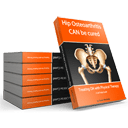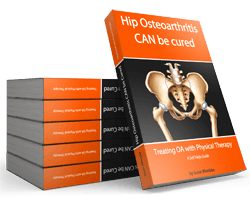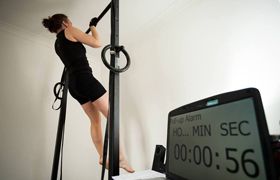Hip Osteoarthritis CAN be Cured - Treating OA with Physical Therapy
-

My Story
10 years after being diagnosed with a 'classic' and incurable case of hip osteoarthritis I am symptom free and enjoying an active life. I hope that by sharing the full details of my symptoms, the diagnosis and prognosis, the battles and setbacks and the ultimate cure through physical therapy, I will help others on the same path as me.
-

Can you be Cured Too?
My symptoms turned out to be entirely due to muscle imbalances. This is likely to be a contributing factor in most cases diagnosed as osteoarthritis. The only way to find out if you can be completely cured is to address the muscle imbalances and see what you're left with. Go to the Self Help Page to get started.
Get Started -

The Self Help Book
By popular request I have shared my experiences and methods in a self-help book. The book explains how to go about identifying muscle imbalances that could mimic, lead to, or even be a consequence of osteoarthritis. It provides general guidance and a detailed treatment plan to correct them.
Learn More
Health professionals say osteoarthritis can't be cured - can they really be wrong?
The biggest hurdle I had to overcome during my battle with osteoarthritis was the fact that the specialists insisted I was incurable. At the time of my diagnosis, nearly everything I could find online overwhelmingly supported their view. Nevertheless every fibre of my being told me they were wrong; this belief didn't stem only from intuition, but also from logic, common sense and my detailed knowledge of the onset and nature of my symptoms.
I know from talking to others that it's normal to be crippled with fear by the bleak prognosis that so often comes with OA. Many people - especially those that are relatively young and active - desperately want to fight back, but faced with a condition they don't understand they're afraid to go against professional advice. They have no one else to turn to.
I realize that in order to help people overcome this fear and make informed decisions I have to address the question: "Can the health professionals really be wrong?" (click on the headings below)
I was diagnosed with osteoarthritis of the hip by my doctor in 2006; X-rays of my hip joints showed degenerative changes, and a specialist confirmed the diagnosis, describing my case as "classic" hip OA. In 2012 physiotherapists felt what they thought was bone-on-bone restriction, and one insisted I'd require hip replacement surgery in a year.
Despite this - through diligent research and self-administered physiotherapy - I've rolled back my symptoms to the point that I have no hip symptoms. My hip is regularly tested in sports and fitness activities and I'm working towards perfecting every aspect of my biomechanics to get myself into the best shape of my life. I'm living proof that the professionals can get it wrong, and if they can be wrong about a "classic" case like mine, they could be wrong about you too.
There are a number of reasons, but here are two of the most important:
- Osteoarthritis is a diagnosis of exclusion; it is given when no other obvious cause for your symptoms is present. However, the process of "exclusion" is often far from rigorous, especially for patients above a certain age.
- In the vast majority of cases there's little to be gained by differentiating between symptoms genuinely caused by the condition of a joint, and those caused by complex muscle imbalances. While the latter is treatable through physiotherapy, patient compliance for even simple ailments is known to be very low. In short, the outcome tends to be the same for the vast majority of cases, regardless of the underlying cause, and those who would devote the time and effort required to improve their condition through physiotherapy aren't even given the chance.
The human body readily adapts to things that we do frequently. Those who sit at a desk all day often develop a 'desk job posture'. If you get an injury, you'll change how you move to reduce pain; this abnormal movement results in muscle imbalance that may persist long after the injury has healed. In the same way, people that do repetitive one-sided sports such as golf or martial arts commonly develop left/right imbalances.
Many imbalances never become problematic, but the more pronounced the imbalance, the more likely it is to result abnormal stress on soft tissues, causing aches, pains, and increased susceptibility to injury. In some people the body responds to this by further adaptation which in turn leads to more muscle imbalances, and a self-reinforcing cycle develops. Ultimately this produces the restrictive, debilitating and painful symptoms commonly associated with OA.
It is now recognized that some people have severe degenerative changes in joints yet remain symptom-free; conversely, some people have little to no visible changes to their joints but suffer greatly from their symptoms. The bottom line is that joint imaging is not a reliable indicator; indeed some major health bodies no longer require its use when making an OA diagnosis.
I think this very unlikely; by the same token, not all OA cases are the result of joint degeneration. What I do believe however is that muscle imbalances will always be present when OA has been diagnosed; if your body is unable to move normally - whatever the root cause - you will have a muscle imbalance.
If a muscle imbalance causes hip pain and other symptoms that mimic hip OA in otherwise healthy people, it stands to reason that an identical muscle imbalance in someone with a hip joint pathology can only make their joint problem worse. In other words, whatever the cause of your muscle imbalance it can only do good to treat it.
Physical problems in major joints like the hips, knees and spine will cause the body to adapt and compensate; this must ultimately lead to muscle imbalances that will create their own symptoms - including pain and stiffness. In addition, these muscle imbalances and movement impairments could put strain on other joints leading to "secondary" osteoarthritis.
Whatever the root cause of your condition, it makes sense to treat your muscle imbalances; doing so must help alleviate at least some of your symptoms.
A number of health professionals I consulted simply wouldn't or couldn't see past my diagnosis - the very mention of osteoarthritis shut them down immediately. Some others were able to detect certain symptoms of my imbalance; they could see misalignment in my spine, or a marked difference in strength and size between certain muscles on one side of my body versus the other. However, their training caused them to focus on the one specific problem they'd seen - the tip of the iceberg - and their attempts to rectify that problem consistently proved ineffective.
If you are unable to move without pain and/or restriction, then it follows that you have a muscle imbalance. I've found that the presence of a twisted pelvis is a good indicator for the muscle imbalances that go hand-in-hand with hip OA. I've provided some tests for this in my self-help guide, and you can find other resources online that can help with your self-diagnosis.
Primarily muscle imbalances are treated through a combination of myofascial release, strengthening and re-establishing correct movement patterns. The difficulty lies in breaking through the self-reinforcing nature of really complex muscle imbalances; you need to know which muscles are dysfunctional, which should be given the highest priority, and which exercises will be most effective.
If that sounds like a job for a professional, think again; You are very the best person to unravel your muscle imbalance. You have the strongest motivation to do so, because you have the most to gain. You have the most detailed possible knowledge of your patient history: the activities you've done throughout your life, the injuries you've suffered, and the aches, pains and stiffness that you've experienced as your condition developed. Finally, you're able to spend more time analyzing and working on your condition than anybody else, and that time comes at no additional cost. All you really need is the knowledge, objectivity, patience and persistence to see it through.
The Purpose of this Web Site and How to Use it
When I was diagnosed with hip OA my prognosis was bleak, and the prevailing message from the health profession was simply this: "accept it". I didn't. Through determined research and experimentation I eventually learned that my symptoms were the result of a complex muscle imbalance, and discovered how to reverse it.
The goal of this website is therefore to increase knowledge about muscle imbalance and the role it plays in osteoarthritis. Even very complex imbalances are treatable; it takes patience and frequent, conscientious self-administered physiotherapy, but it can be done. The site also provides additional resources that complement the information and treatment plan in my self-help book.
Whether or not you're working from the book I recommend you start on the Self Help page and work your way around the web site from there.
Let me know what helps and what doesn't. he more feedback I receive the better able I'll be to provide info that really helps people to succeed in their battle against osteoarthritis.
Go to the Self Help Page and Get Started Now!No one should give up hope of a complete cure on the basis of an osteoarthritis diagnosis.
Feedback
Fran
"Whatever the outcome of our chats, you have made such a difference to my outlook. For that alone I am indebted to you."
"I found Susan from her first post, and remember that "Ahh.." moment. She has been hugely helpful, and definitely a light in the wilderness of the medical profession. I am not cured...I have hip OA, but have control over the associated pain that came from overcompensating for the hip."
"Nine months since I first responded to you , Susan, although I read all your posts. This last response of yours was such a clear summary of the basic issue - that doctor's are not gods, and we need to take charge of our own outcomes as much as possible."
Viking
"You have hit the nail on the head here. I am sure the medical profession classifies a lot of issues as osteoarthritis and takes the view its incurable. The level of examination appears to me to far too limited and the diagnoses far too simplistic if you get one at all !!!"
Leesa
"Thanks again so much for your time. I'm so grateful that you are there for us :-) also, please could you let me know if you have a youtube channel or the likes that i can subscribe to if that's ok."
Mary
"Susan, your posts are so incredibly informative and tremendously enlightening. I have been diagnosed with knee osteoarthritis and pressured by some physicians into surgery, although one suggested riding it out. I have been acutely proactive and trying various ways and means to work with my injury. Your post resonates so acutely with me as I KNOW now after re-reading your research that my issue is related to soft tissue damage surrounding an injury to my knee exacerbated by a running injury."
Dee
"Firstly thanks a lot for sharing such great details of your research.It really has given me hope & a new perspective towards the situation."
Marie
"Susan: Thank you for the quick reply and I am astonished and tears are in my eyes that someone finally has a good idea of why I have this pain. I will get the book called Trigger Point Therapy and have just massaged the muscle and it feels better already. It's been a long, long time and I thank God I found you.Thank you again for being so diligent."
Angelika
"I am definitely going for the soft tissue issue and will do a lot of research on this. I do feel the doctors did not have enough information to give me this diagnosis."
Ann
"Thank you for this post, Susan! I have recently been diagnosed with OA and I just felt odd about the doc's attitude. Your post is the first thing that popped up when I searched for answers. The information you have shared is great!"
Claire
"It is good to feel empowered, to be able to relieve the symptoms oneself. I cannot thank you enough, Susan. To be able to walk normally makes me feel euphoric!"
"I have been wondering if my own muscle imbalance is due to 30 years in my dental practice, twisting to the left, either seated by the patient or standing up. My right leg is shorter than my left."
Janet
"It's very motivating to feel someone else has experienced this sort of problem and overcome it against all medical advice"
RCLS
"You tell an interesting even inspiring story. It would be very helpful to all if you would tell us about your process. What type of professional help if any? How did you work out which exercises and for which muscle, and how to know that the hip was healing. As much information as possible will allow others to at least begin to check themselves out. It would be a pity to tell your story and stop there."
Cat
"I just couldn't find better words to express my gratitude, and just by following your suggestions on which muscles to strengthen, I'm back to normal, no pain at all"
Janet
"I do believe a website would make a great difference to all those out there who haven't found you yet. Countless Google searches on my part, over the best part of twelve months have never spotted your comments until now, so heavily surrounded and deeply hidden among doom and gloom sites recommending surgery and claiming OA is not repairable. So if ever you find the time I would urge you to set one up but if not, let's just be grateful you find time to reply to these posts."
Maureen
"I just want to thank you from the bottom of my heart, Susan, for all the time you've given in helping people. You are a Godsend!"
Marcy
"I too am 42, fit, active and just been diagnosed with hip and back OA. I am looking for answers as well. I won't take this laying down and would love any info you have on muscle imbalance. Thanks for your uplifting post Susan!"
Pat
"to back up your theory.I am an optometrist for 20 years .in the same slightly twisted posn all day..think its my root problem. Also looking forward to the detailed step guide to addressing it"
David
"I am amazed and frankly stunned that no-one of the so called 'health experts' I have visited has ever mentioned it [trigger point self treatment] to me and I had to discover it through the dedicated efforts of someone like you online - I only stumbled across the forum and your posting by accident and if I hadn't I never would have known about this book"
There is no silver bullet; The first step towards a cure is the acceptance that the only person that can put this right is you!

About the Self Help Book
After repeatedly being told "you should write a book about this", that's what I did. My self-help guide exposes still-prevalent myths about osteoarthritis and explains how to identify muscle imbalances that can lead to, or exacerbate, the symptoms of OA. It concludes with diagnostic tests to establish the precise nature of your imbalance and a series of self-administered physiotherapy exercises designed to correct those imbalances.
More Information / PurchaseExtreme fitness after age 50 (and after a hip OA diagnosis) is possible!
My experience with OA has taught me that many of the physical symptoms associated with age-related decline are in reality the cumulative result of disuse and muscle imbalance. The hugely challenging task of understanding and reversing the imbalances that are causing the problems in your hip - and aches, pains and stiffness all over your body - equips you with awareness, knowledge and skills that few possess. You will be equipped with the skills needed to not only restore your body to 'normal', but to aim much higher and avoid so called 'age related decline'.
You don't have to wait for 'cure' before starting your journey towards 'physical perfection' and extreme fitness. With intelligent adaptation, you can treat your OA whilst still pursuing extreme fitness goals. [NOTE:The pursuit of extreme fitness isn't a requirement!]
Now in my mid fifties, I'm using what I learned whilst eliminating my hip problem to help me get into the best shape of my life; I want to perform better in sports than I ever did in my twenties. Currently I'm working on calisthenics (e.g. Flags, levers, muscles ups), bodybuilding and general strength development. All with a focus on perfecting bio-mechanics. Over the coming months and years I plan to develop all aspects of fitness and physical development. I'll share my progress and my approach to rehab through extreme sport on the Extreme Training section of the website.
Find Out MorePersonal Bests and Outstanding Performances Could Still Be Ahead of You!




